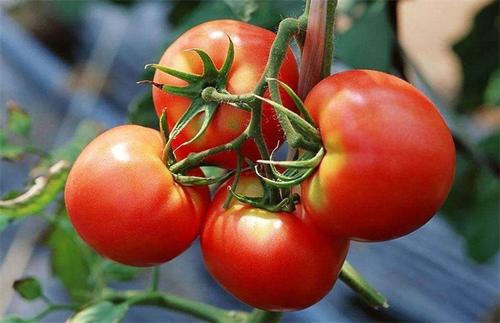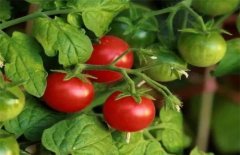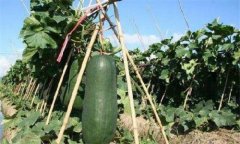How to plant and manage tomatoes: the planting method of potted tomatoes and the correct method of watering
Do you want to grow your own vegetables on the balcony? Then it is better to grow tomatoes, which is simple and has a high survival rate. if you are planting for the first time, you can take a look at the following introduction, how to plant, how to plant and how to manage it, and how to fertilize and water during planting.

If you start planting seeds, plant them in a greenhouse or by a sunny indoor window for a month, and then move them to the yard. When the seedlings grow to 15-25 cm high, they can be transplanted into the yard. Or plant seedlings on a tray, a plate of six small plants, each divided into an area of 3 centimeters in diameter.
Transplant: transplant plants to a sunny place. Tomatoes need at least 7 hours of sunshine a day to get the best taste.
Note: when the weather becomes hot and the lowest temperature reaches 24 degrees Celsius at night, do not plant new tomatoes. What has been planted will grow well, but there is no way to sprout in such hot weather.
The date of moving the tomato outdoors should not be too many days later than the best date, or it will be too late (not if the temperature is already high at night). Add a large amount of compost to the soil of the yard in advance (25-40 kg per square meter). It should be fully fermented, not newly collected. Bury the compost in the top layer of the soil, 6-8 cm. The growth medium of tomato needs to be rich in organic matter. If you don't make your own compost, you can buy ready-made compost or fertilizer at the store. It costs about 30 yuan for a bag of 20 kilograms.
Planting process:
Tomato seedlings should be buried deep in the soil. The soil should be buried to 50% of the seedling length, 75% of the seedling length (especially those seedlings with very slender stems before transplanting), and it is okay to bury some of the lower leaves. New roots grow on the stems buried in the soil to promote plant development. The growth of roots is the most important thing to pay attention to when transplanting plants. Each seedling is watered with 4 liters of warm water (about 27 degrees Celsius) within 10 minutes to avoid transplant shock. The interval between each two tomatoes should be 45-90 cm. If the climate is warmer, especially when using tomato cages, the interval should be halved. Normal intervals help tomatoes spread out widely on the ground. if planted more closely in cages, the branches and leaves of tomatoes will block each other's fruits, prevent the sun from getting too hot, and help to get sweeter fruits.
Watering: 500 milliliters of warm water per plant per day within 7-10 days after the completion of transplantation. At the same time, it keeps the soil moist in dry weather. The mulch should be 2.5 cm thick and cover at least 30 cm in diameter around each tomato seedling. The use of pine needles is especially helpful to improve the acidity of the soil.
Note: don't keep the soil wet all the time, it will suffocate the roots, especially in warm or hot weather, and can lead to stem fungal infection. Drip irrigation or watering with seepage pipes is better than pouring water directly from the top down, because the latter increases the prevalence of plants and tomatoes are particularly prone to disease. Ten days after transplantation, the interval between two watering times was widened, while ensuring that the plants got 2.5cm to 7.6cm Rain Water per week. Two weeks after the transplant, if it doesn't rain, each tomato should be watered 7.5 liters a week. Water 2-3 times a week, thoroughly. Each plant is watered 3-4 liters at a time. As the seedlings grow bigger and the weather gets hotter, the amount of water should increase moderately. In hot or dry weather, you can increase the frequency and amount of water.
- Prev

How to grow and manage tomatoes: what kind of fertilizer is used to grow tomatoes? How to fertilize tomatoes
Do you know how to grow tomatoes? How to grow tomatoes and how to manage them? If you want to grow tomatoes, you can take a good look. The following is accepted. In terms of growing vegetables, fertilization is very important. The tomatoes.
- Next

Planting technology and management of wax gourd, planting time and technology of wax gourd how to fertilize wax gourd
Wax gourd is a kind of vegetable, there are many people like to eat this vegetable, so if you want to grow wax gourd, how to grow it? Friends who want to grow wax gourd can take a look at the following article to know how to grow wax gourd. Wax gourd is an annual.
Related
- A one-day flower show brings 130 million yuan in orders! Nanhai, this Phalaenopsis exhibition is amazing
- What do the flower language and meaning of Lutheran tree mean? Precautions for planting Lutheran tree
- Encounter Chaoshan Kongfu tea, not without this cup of Phoenix single clump
- The durian market in Vietnam and Thailand is flooded. The price of imported durian has plummeted by 30-40% in a month.
- Shanghai solved the problem of local vegetable supply by planting 80,000 mu of green leafy vegetables.
- Wageningen University has become the best agricultural university in the world for the seventh time in a row.
- The strongest export season of South African grapes is full of challenges, with exports to Russia falling sharply by 21%.
- Sri Lanka is on the verge of bankruptcy, "Tea for debt" Organic Agriculture Revolution aggravates the Food crisis?
- Turning waste into earthworm manure and worm manure into organic fertilizer-A new choice for auxiliary farming
- Organic rice growers shoulder the responsibility of nurturing agricultural talents! Yinchuan Sustainable Farm with Organic Life Camp

